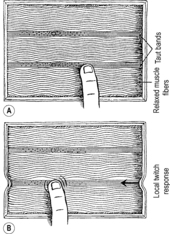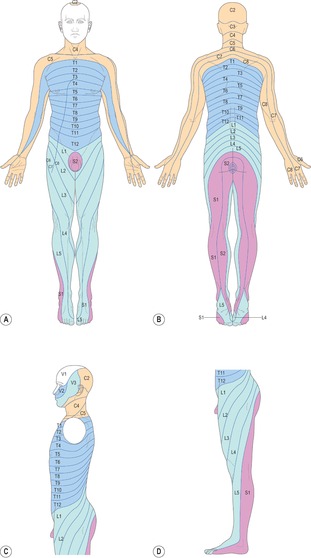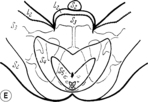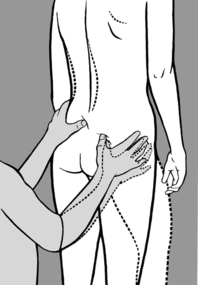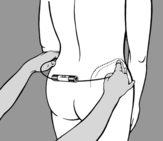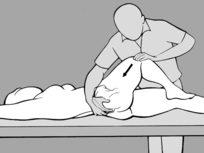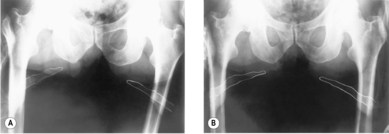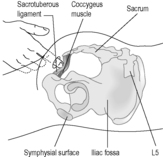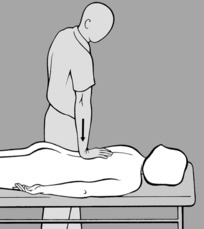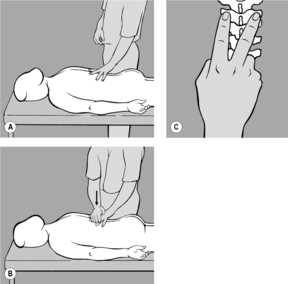Following the patient history, the next step is the physical examination. There is no clinical field in the whole of our experience in which the purely clinical examination plays such a decisive role; nor does any other make such high demands as the examination of motor function. The examination begins the moment the patient enters – the very first steps into the room, the way the patient sits down, even the way the patient undresses. It is important that patients should undress for the first examination (to their underwear, since most patients feel more at ease if they can keep their undergarments on, and so move more naturally). Present-day knowledge of functional inter-relationships shows it to be essential to study the entire locomotor system at the initial examination.
4.1. Patient history
4.1.1. Course of the disease
Unless we are dealing with a young patient, symptoms will usually have been present for some time;
in most cases for years or decades, though sometimes in mild form, interspersed with periods of complete absence of pain. The frequency, duration, and intensity of the individual episodes are all relevant, but such details can often only be discovered by careful, specific questioning. For example, female patients will tend not to recall or mention low-back pain during menstruation unless specifically asked, because they consider this irrelevant. In contrast to this pattern, a short, progressive course should give rise to concern, especially if the patient is advanced in age.
4.1.2. Localization
Over the course of years, pain may occur in various different parts of the spine and locomotor system; it is exceptional for dysfunctions to remain confined to a single region. Again, specific questioning is usually needed to elicit this information. Patients presenting with headache will have little idea that there might be a connection between this and their low-back pain, any more than patients with lumbago will associate this with vertigo originating from the spinal column.
Patients may suffer from a number of complaints that might, if taken individually, be seen as having a variety of different causes, yet all have a common denominator in the spinal column or locomotor system. The greater the number of complaints a patient has – all of which, however different, could have a vertebral origin – the greater the likelihood that these are indeed vertebrogenic dysfunctions. This serves to confirm
Gutzeit’s (1951) view that the spinal column is the link that runs like a bright red thread through a thoroughly varied list of different complaints.
Vertebrogenic pain is typically asymmetrical as between sides and often unilateral. This applies both to radicular pain and to reflex, referred pain such as headache or pseudovisceral pain. The asymmetry usually increases as a patient’s condition deteriorates, and decreases as it improves. If (in the case of dysfunctions) a unilateral pain spreads to become bilateral, this does not usually indicate deterioration.
4.1.3. Trauma
As has already been emphasized (in the discussion of pathogenesis), trauma is a significant factor in the etiology of vertebrogenic disturbances. If an accident features in the previous history it becomes all the more likely that the presenting complaint has a vertebral origin. Almost any kind of trauma, even if it ‘only’ affects the limbs, affects the spinal column. This is particularly so in the case of head injury. Nevertheless, it is well known that many patients tend to forget ‘minor’ injuries, serious as the consequences often turn out to be. Children who wrench their neck in an awkwardly performed somersault in a gymnastics lesson at school, or fall and sit down heavily, seldom suffer any painful consequences at the time; if they do, they compensate quickly. However there can be consequences, but they often appear very much later. It is therefore advisable not to accept straight away an answer that your patient cannot remember ever having had any accident. Instead, it should become a routine question to ask patients what sports they practice. To give a typical example: a patient who answered a direct question about injury by saying that he ‘never suffered any trauma’ replied to one about sport by saying that he had been a boxer!
4.1.4. Load, posture, and position
Function and its disturbances in the locomotor system are influenced by movement, load, posture, and position, especially if the position maintained is stressful. Therefore one of the most important points in recording the case history is to discover under what conditions the pain occurs. This is not only useful in arriving at a diagnosis, but also important from the point of view of prevention.
Details in the history such as these are essential, but often very difficult to discover from the patient. It does little good to ask what happened just before the onset of symptoms, because patients will give an answer based on all sorts of theories they have heard or formed for themselves. What we need to know are the circumstances in which pain was initially felt and which cause it to recur on a regular basis. Patients often find this very difficult to recall, thinking that it would not help to say, for example: ‘when I got up from my chair …’; ‘I was shaving, and when I tried to look more closely in the mirror …’; ‘… getting out of bed in the morning …’; ‘I was going to pick up a piece of paper from the floor …’; yet these are significant details.
In this context too it is necessary to find out about patients’ work and sporting activities.
4.1.5. Non-mechanical factors
Dysfunctions of the locomotor system are not simply a mechanical problem, but involve every aspect that affects the reactive capacity of the body. The nervous system in particular plays a role, as can be seen in susceptibility to changes in the weather, to chills, and infectious diseases. This is especially so if these cause raised body temperature. Hormonal disturbances, the clearest effects of which are those experienced by women during menstruation, can also be important; allergy can likewise have an effect.
4.1.6. Psychological factors
Since, as we know, the locomotor system is subject to human will, and pain is the most frequent symptom of dysfunction, it is hardly surprising that psychological factors play an important part. Psychological involvement in no way excludes, but rather corroborates, the diagnosis of vertebrogenic dysfunction. It must be stressed that appropriate treatment of the dysfunction is the best means of easing the pain. It also provides the practitioner with the best means of dealing with the psychological problems. It is ultimately the course of the illness that indicates how significant the psychological factor is in the particular case. The psychological problems may ease when the patient’s pain is relieved, or may persist; they may even cause relapse as a result of increased muscle tension, and an inability to relax. This is particularly the case in masked depression.
One general principle needs to be stressed: we should guard against categorizing pain as psychological if patients are able to localize it accurately and if they give the same account of the symptoms each time they describe them. The conclusion we should draw in this case, assuming that no pathomorphological lesion is found, is that there is a dysfunction of the locomotor system. Signs that a problem is caused by purely psychological factors are these: if the patients are unable to localize the pain, if they constantly change their account, or if they cannot describe the pain. They are often confusing their psychological suffering with the pain.
4.1.7. Paroxysmal character
Gutzeit (1951) is entirely right when he describes the paroxysmal character of vertebrogenic complaints, especially if the symptoms involved are autonomic and vasomotor in nature: examples are headache, vertigo, pseudocardiac or other pseudovisceral problems. If the pain has the same, sustained intensity, for example headache, this tends to suggest another cause rather than a vertebral one. At the same time it should be pointed out that patients often speak of pain as being ‘constant’ when they are never completely free of it, although its intensity rises and falls paroxysmally with a certain frequency.
4.1.8. The significance of patient age
For differential diagnosis it is important to bear in mind that the age of the patient plays an important role. In adolescents we might expect to find ‘ordinary’ restrictions or juvenile osteochondrosis, and in slightly older patients, ankylosing spondylitis. In the middle-age group, the most common serious conditions are herniated disc and ‘ordinary’ dysfunctions. In older age groups, osteoporosis is the most important, especially in women; also osteoarthritis, especially of the hip and knee joints. In this older age group, malignant disease must also be considered, especially if the patient is over 50 years of age and the disease has followed a progressive course. True vertebrogenic disease tends to decrease after the age of 60, accompanied by a rise in the incidence of osteoarthritis of the limb joints.
4.2. The inspection: posture
4.2.1. The dorsal aspect
The inspection begins with an assessment of overall posture, looking for any deviation from the plumb line and any asymmetries.
The next stage is the systematic inspection. Working upward from the feet, the specific points to examine are:
• the shape (roundness) and position of the heels
• the shape and thickness of the Achilles tendons and the calves, observing their medial and lateral contours
• the position of the knees
• the shape of the thighs
• the height of the gluteal folds
• the tone of the gluteal muscles
• the course of the intergluteal cleft
• the shape of the hips: whether symmetrical or projecting to one side
• the distance of the pendant arms from the trunk on either side.
Further details to examine are:
• the rhomboid of Michaelis between the dimples situated at the posterior superior iliac spines (PSIS), and further craniad, the prominence of the erector spinae muscles. Between these lie the spinous processes, set within a groove between these muscles. This may follow a vertical course, or may be found to deviate from the vertical
• the apex of the lordosis and the transition to kyphosis
• the position of the shoulder blades: how high, and, if prominent, how symmetrical
• the relative height and shape of the shoulders
• the quadratus lumborum and latissimus dorsi muscles; these form the lateral contour of the trunk up to the axilla. The superior border of the shoulders is formed by the deltoid and superior portion of the trapezius, and medially to these by the levator scapulae. The inspection should note whether the superior contour takes a concave or convex (hypertonic) course and observe whether there is symmetry
• the neck: note whether the neck deviates to one side or the other, and observe whether it is long, slim, or stocky
• the hair line: note whether this is well above the shoulders or low down as in basilar impression
• the head: look for any deviation. Does it deviate to the same side as the neck, or to the opposite side?
4.2.2. The lateral aspect
Inspection of the lateral aspect also begins with an assessment of posture as a whole. The center of gravity of the head should normally be above the shoulder girdle; more precisely the external auditory meatus should be vertically above the pelvic girdle and this in turn above the feet, so that a plumb line from the external auditory meatus falls approximately 2cm in front of the ankles and touches the scaphoid of the foot (navicular bone). During this inspection the patient’s gaze should be directed at an object at eye level.
It is extremely important to register a forward-drawn position, in which the head is in front of the shoulder girdle, and this in front of the pelvic girdle, with the pelvis above the anterior part of the foot.
It is important for diagnosis to note any tension of the muscles of the back, and especially of the back of the neck, which disappears on sitting.
When carrying out the systematic inspection, the examiner again works upward from the feet. Points to assess are:
• the shape of the lower leg and especially the knee: genu recurvatum is a sign of laxity
• the shape of the buttocks
• the lumbar curvature: note whether the apex of the lordosis is located at or above the lumbosacral junction. In cases of increased lordosis with flabby posture, the abdomen is seen to protrude; this is not always a sign of adiposity. This protrusion may be at its maximum at the navel; however, if there is a drooping belly the level may be much lower
• the level of the transition from lumbar lordosis to thoracic kyphosis: note whether the patient has a flat or round back; if the thoracic spine is flat there is frequently increased kyphosis at the cervicothoracic junction
• the shape of the spinal column
• the position of the shoulders: whether drawn forward or protruding.
Cervical lordosis largely depends on the shape of the thoracic spine. If the thoracic spine is flat, cervical lordosis may be completely absent. This is particularly seen in individuals of the athletic type with broad shoulders and a flat thoracic cage; similarly in ballet dancers. If the back is round, on the other hand, the thoracic kyphosis often continues into the lower cervical spine, with only the upper part of the cervical spine showing lordosis.
In flabby posture, exaggerated cervical lordosis is sometimes seen; the thyroid cartilage (and trachea) may protrude, giving the impression of an enlarged thyroid gland. This, however, disappears in the supine position.
In a forward-drawn posture there is frequently hyperlordosis in the craniocervical region.
4.2.3. The ventral aspect
At inspection of the ventral aspect the most striking features are asymmetries between one side and the other, especially those that fall into the category of hemihypertrophy. Working from caudal to cranial, the points to observe are:
• the position of the feet and their transverse and longitudinal arching
• the knees: varus or valgus alignment
• the lower abdomen. Note a protruding abdomen and also the navel; the position of the navel is important. Specific points to note are whether it is central, and whether it lies on the surface or at some depth. If the patient has a large abdominal circumference and the navel is deep-lying, this indicates corpulence, but if the abdomen is enlarged and the navel ‘floats’ in a superficial position, it is indicative of muscle weakness. The lateral contours of the abdominal wall are normally concave, but if the abdominal muscles are weak, the contour is convex bulging
• the epigastric angle: this may be obtuse or acute
• the sternum and pectoral muscles. It is mainly in male patients that these are easily seen
• the clavicles, noting how they move during inhalation and exhalation and the extent to which they participate in the movements of respiration (markedly or little). The depth of the supraclavicular fossae is important; these are deeper when the thoracic cage remains in an inspiratory position, as happens in emphysema, for example, or where there is a functional problem of faulty breathing. In this case there is also hypertonus of all the other upper fixators of the shoulder girdle, which is manifested as a ‘Gothic shoulders’ posture
• the position of the shoulders: asymmetry is almost the general rule
• the jugular fossa in the neck region between the medial ends of the clavicles, and the sternoclavicular joint: one joint is often found to be more prominent than the other, although this need not be clinically significant. The sternocleidomastoids can be seen either side of the jugular fossa; the lateral attachment of this muscle on the clavicle is usually less distinct. Between the sternocleidomastoids and the trapezius, some bundles of the scaleni may be visible in slim patients
• the thyroid cartilage: this can be seen more distinctly in males. Any lateral shift in its position is clinically very significant, since this indicates tension in one of the digastric muscles, drawing the hyoid to one side along with the thyroid cartilage. This observation is accompanied by distortion and asymmetry of the floor of the mouth, which is shallower on one side and deeper on the other
• hyperactivity of the masticatory muscles: this can often also be seen at rest. Another manifestation is that the patient’s mouth hardly opens during speech.
• the face: facial asymmetry is very frequent, and can be combined with asymmetry of bite and even ‘facial scoliosis.’ This in turn can be associated with scoliosis of the spinal column and hemiatrophy.
4.2.4. Inspection of the seated patient
Examination of the patient in the relaxed, sitting position can produce very different results from those obtained with the patient standing. This is particularly so with hypermobile subjects, in whom lumbar hyperlordosis standing changes to a kyphotic posture when seated and relaxed. This is accompanied by a forward-drawn neck and hyperlordosis at the atlanto-occipital and atlantoaxial joints. This is particularly important in subjects whose profession is mainly sedentary.
Inspection from above would reveal rotation of the shoulder girdle in relation to the pelvic girdle and the feet.
4.3. Palpation (soft-tissue examination)
Palpation is extremely important in the diagnosis of painful structures of the locomotor system and essential for all manipulative techniques. This examination therefore follows next, immediately after the inspection.
The first step in palpation is to place a hand (finger) onto the surface of the patient’s body, and then to focus one’s attention on the aspect to be tested: warmth, moisture, consistency (whether the surface is rough or smooth), mechanical properties (resistance, mobility, stretch capacity), and whether the examination causes the patient to feel pain.
Given that palpation is associated with touch, and this in turn with pressure, we might think that an objective way to perform it would be to use a pressure gauge. Sadly this idea is misleading; palpation is never a matter of mere (static) pressure, but a process that involves movement of the hands (fingers).
Whether attempting to penetrate down from the surface to underlying layers, or to examine some aspect of the tissue by feel, we are constantly moving tissue aside or drawing it apart. Palpation therefore involves a combination of alternating pressure and movement. It is registered using not only our pressure receptors but also, simultaneously, our proprioceptors.
Further, touch constantly evokes a reaction from the patient, and this reaction must also be registered. Feedback operates between the examiner and the patient, and is extremely important in diagnosis; a non-reproducible process of feedback is taking place between two systems.
Palpation is a method that reveals a great deal to the experienced examiner; a host of information that a technological instrument is incapable of providing. The fact that it is not reproducible frequently leads to its rejection as too subjective: however this is not only absurd on practical grounds but also theoretically untenable; computers that process information are in essence no more than imperfect copies of the nervous system. The information that we obtain from them is uncritically accepted as ‘objective’ while the original, the human brain and the hands that provide the sensory input of information, are rejected as unreliable. Yet there is already radiological evidence to demonstrate ‘palpatory illusions’ (see
Figure 4.11).
The palpating hand has receptors to sense heat and cold, to distinguish pressure, motion, position, and tissue quality. No technological instrument is able to detect and integrate all these factors simultaneously. There is also a feedback process between practitioner and patient, both during diagnosis and during treatment.
4.3.1. Hyperalgesic zones
The quickest, most elegant method of finding a hyperalgesic zone (HAZ) is to run one’s fingers very lightly over the surface of the skin: heightened friction is felt at an HAZ on account of increased sweat production. The lighter the touch of the fingers, the more readily this is detected. The ‘barrier’ phenomenon is used when examining all the tissues of the locomotor system other than bones (see
Figure 2.3). The points to note are:
• the point at which the first resistance is felt on moving away from the neutral position: on stretching or folding the skin, stretching a subcutaneous fold, or displacing muscles relative to the bone
• in the movement of a joint, the point at which the barrier is reached
• whether the barrier is normal or pathological.
A small area of skin can be examined by stretching it between the fingertips (the interdigital folds are an example) – a larger area is examined between the thumbs and the palms of the hands – always taking up the slack until the point where the barrier is engaged, and always comparing one side with the other (see Figure 6.56).
4.3.2. Subcutaneous tissue and fasciae
To examine – and also treat –
subcutaneous connective tissue, including that in scar tissue and shortened muscles, the practitioner should create a fold (see
Figure 6.57) and stretch (not squeeze) it until the barrier is reached. If it is not possible to create a fold, slight pressure alone is enough to arrive at this barrier.
In examining
fasciae, the most useful characteristic to look for is their mobility against the underlying layer, that is mobility of the subcutaneous layer against the muscle and especially of the muscle against the bone. This mobility is examined as follows:
• The muscles of the back in the cranial or caudal direction, with the patient prone.
• The gluteal muscles in the cranial direction.
• The muscles around the thorax in the dorsoventral direction.
• The muscles of the neck around the longitudinal axis of the neck.
• The muscles of the limbs around their longitudinal axis (
pp. 232–234).
The scalp also behaves in the same way as a fascia relative to the skull.
Resistance (pathological barrier) is often discovered at periosteal pain points when trying to shift the subperiosteal tissue in various directions, and an easing of the pain is achieved when mobility is restored. This applies particularly at the attachments of tendons and ligaments.
Bones that are linked not by joints but by connective tissue also move relative to one another. Examples are the metacarpal and metatarsal bones, and the fibula relative to the tibia. Testing of their mobility relative to each other often reveals pathological barriers, which are treated in analogous ways. Everything that has been said about soft-tissue lesions applies to active scars.
The soft tissues surround the muscular and articular structures everywhere, and need to move in harmony with them. The same principle also applies to the internal organs. For this reason, dysfunctions that are closely associated with the function of joints and muscles can be diagnosed in the soft tissue. It is the mobility and elasticity of the soft tissues that enable them to move, and there is a harmonious interplay between these and movement. This mobility has been little studied, but if it is disturbed, the neuromusculoskeletal system cannot function normally.
4.3.3. Trigger points
A muscle bundle in which there are TrPs contains some muscle fibers that are in a state of contraction, alongside others that are uncontracted (relaxed). If we succeed in relaxing the contracted fibers, using post-isometric relaxation, reciprocal inhibition, ‘spray and stretch’ or simple pressure, the problem usually disappears instantly, showing it to be a functional, reversible disturbance.
Recent studies show that the hardening derives from the part of the muscle fiber that is stretched, and that the nodule of contracted muscle is the actual myogelosis. These changes have also been demonstrated histologically (
Windisch et al 2001), findings which indicate that there are also TrPs that are chronic and irreversible. These respond little to the reflex methods mentioned above, requiring instead aggressive therapy such as needling (see
Chapter 6, p.
248).
Myofascial TrPs can also be studied objectively by means of electromyography (EMG) using monopolar needle electrodes. This method has successfully been used (
Hong & Yu 1998;
Hubbard & Berkoff 1993;
Simons 2003) to show that what they were observing were end-plate potentials originating in TrPs.
Two kinds of TrP can be distinguished: active and latent. Active TrPs are those that give rise to pain, especially referred pain. Latent TrPs do not give rise to spontaneous pain, but are painful on palpation and participate, often decisively, in chain-reaction patterns.
Myofascial TrPs are not the only pain points that can be palpated; points of tenderness can also be found at the periosteum, in joint capsules, at attachment points of tendons and ligaments, and within muscles in the absence of any area of hardness. Since the hardened area forms part of the definition of a ‘TrP’ the term cannot strictly be applied in this case and instead it is best to use the term ‘tender point’ (TeP). These can also be the point of origin of referred pain. If the TeP is the attachment of a tendon, this is usually closely associated with the TrP of the corresponding muscle, the actual cause of the pain at the tendon attachment.
Characteristic muscular pain points are also present in system-wide disease, as for instance in fibromyalgia syndrome, but a particular feature of these is that there are no areas of hardness. There is also no twitch response, and these pain points do not respond to reflex relaxation.
Table 4.1 lists some muscle TrPs that are important for their diagnostic implications.
Table 4.1 Muscular trigger points
| Muscle |
Clinical significance |
| Soleus |
Pain at the Achilles tendon |
| Quadriceps femoris |
Lesion in L4 segment; pain at the upper edge of the patella; ‘pseudo hip and/or knee pain’ |
| Tensor fasciae latae |
Pain at the hip and at the superior border of the patella |
| Thigh adductors |
Lesion in the hip joint; TrP in pelvic region |
| Iliacus |
Lesion in S1 segment; coccyx; pseudovisceral pain |
| Piriformis |
Lesion in L5 segment; ‘hip pain’ |
| Ischiocrural muscles |
Lesion in segments L5, S1 (straight-leg raising test positive); pain at the ischial tuberosity and head of the fibula |
| Levator ani |
Pain at the coccyx |
| Coccygeus |
Low back pain; many chain reactions due to pelvic floor dysfunction |
| Erector spinae |
Back pain in the corresponding segment |
| Psoas major |
Pseudovisceral pain; restricted rotation of trunk |
| Quadratus lumborum |
Acute lumbago; restricted rotation of trunk |
| Rectus abdominis |
Tenderness at xiphoid process and pubic symphysis; pseudovisceral pain |
| Pectoralis major |
Pain at chest wall; pseudocardiac pain |
| Pectoralis minor |
Tender coracoid process, sternocostal joints, and superior thoracic aperture |
| Diaphragm |
Chest pain; cervical syndrome |
| Transverse (middle) part of trapezius |
Cervicobrachial and radicular syndromes |
| Subscapularis |
Pain in the shoulder; in the arm; at the lesser tubercle; pseudocardiac pain |
| Supraspinatus, infraspinatus |
Pain in the shoulder; in the arm; at the greater tubercle |
| Supinator, biceps brachii, forearm extensors |
Radial (lateral) epicondylopathy |
| Triceps brachii |
Pain in the axilla; epicondylopathy |
| Finger flexors |
Ulnar (medial) epicondylopathy |
| Descending (superior) part of trapezius |
Neck pain; headache and shoulder pain |
| Levator scapulae |
Shoulder pain; headache; neck pain |
| Scalene muscles |
Pain at Erb’s (supraclavicular) point; at the superior thoracic aperture |
| Craniocervical extensors |
Upper cervical syndrome |
| Sternocleidomastoid |
All cervical syndromes |
| Masticatory muscles |
Earache; upper cervical syndrome |
4.3.4. Periosteal pain points
Numerous pain points on the periosteum are also found in most cases of dysfunctions of the locomotor system. The appearance and resolution of these pain points – as well as their treatment – play an important role in the course of the dysfunction.
Many periosteal pain points are sites of attachment of tendons or ligaments closely associated with TrPs in the muscles, and have the effect of producing increased tension there. This is called enthesopathy. On examination, mobility testing of the subperiosteal tissue against the underlying bone reveals characteristic resistance in one or more directions on the affected side as compared with the healthy side.
Pain points can also be found in the region of the vertebral and limb joints wherever these are accessible to palpation. At the spinal column this is particularly so in the cervical region. They are also found at the sternocostal joints and at the temporomandibular joint.
Table 4.2 lists the most important periosteal points and their clinical significance.
Table 4.2 Clinically important periosteal points
| Periosteal point |
Clinical significance |
| Head of metatarsals |
Metatarsalgia in the case of splay foot; also in the case of tarso-metatarsal restriction |
| Calcaneal spur |
TrP of deep plantar flexors |
| Head of fibula |
TrP in biceps femoris, tibialis posterior; restriction of fibular head; forward-drawn posture |
| Pes anserinus (tendinous expansions of muscles at medial border of tuberosity of tibia) |
TrP in the hip adductors; osteoarthritis of hip joint |
| Insertion of collateral ligament |
Lesion of a meniscus in the knee |
| Superior border of patella |
TrP in quadriceps femoris and tensor fasciae latae |
| Ischial tuberosity |
TrP in the ischiocrural muscles |
| Posterior superior iliac spine (PSIS) |
Frequent but not specific |
| Lateral border of the pubic symphysis |
TrP in the hip adductors; hip |
| Superior border of the pubic symphysis |
TrP in the rectus abdominis; forward-drawn posture |
| Coccyx |
TrP in the levator ani, tension in the gluteus maximus |
| Iliac crest |
TrP in the gluteus medius and quadratus lumborum |
| Pain at spinous process |
Hypermobility with TrP in the erector spinae muscles |
| Spinous process T4—T6 |
Weakest region of erector spinae with TrP |
| Spinous process of C2 |
Lesion in segments C2—C4; TrP in levator scapulae |
| Xiphoid process |
TrP in rectus abdominis |
| Ribs in the medioclavicular line |
TrP in pectoralis minor |
| Ribs in the axillary line |
TrP in the serratus anterior |
| Sternoclavicular joint |
TrP in the scalene muscles and superior parts of the pectoralis muscles |
| Sternum just below 1st rib |
Sternocostal joint of 1st rib |
| Angle of ribs |
TrP in subscapularis; restriction of ribs |
| Sternal end of clavicle |
TrP in sternocleidomastoid |
| Pain at Erb’s point |
TrP in scalene muscles; radicular syndromes |
| Transverse processes of atlas |
TrP in sternocleidomastoid |
| Posterior margin of foramen magnum |
Restriction of retroflexion at C0/C1; headache; migraine |
| Nuchal line |
Referred pain from the short craniocervical extensors, insertion of splenii capitis muscles |
| Condylar process of mandible |
TrP in masticatory muscles |
| Hyoid |
TrP in digastric and mylohyoid muscles |
| Styloid process of radius |
Lesion of the radioulnar joint |
| Radial (lateral) epicondyle |
TrP in biceps, supinator, extensor muscles of the fingers |
| Ulnar (medial) epicondyle |
TrP in flexor muscles of the fingers |
| Attachment of deltoid |
TrP in deltoid; frozen shoulder |
4.3.5. Radicular syndromes
As already stressed, radiating pain alone (even mere paresthesia) are not sufficient for the diagnosis of a radicular syndrome. Conclusive evidence of radicular syndrome is provided by
neurological deficit, the main signs being:
• localized hypotonia and/or atrophy
• decreased tendon and periosteal reflexes
• increased idiomuscular excitability.
Unless these signs are present we may suspect root lesion, but this requires further proof.
There are certain signs, however, which strongly suggest radicular syndrome, without being positive proof. These are if the pain and paresthesia radiate down to the fingers (or toes), especially if objective examination also finds increased resistance to stretching at the interdigital fold, and difficulty in the mobility relative to each other of the metacarpals (metatarsals) in the corresponding segment. If the straight-leg raising test produces a finding below 45°, this also raises suspicion. Another sign is when the patient reports that control of the limb feels different from usual.
The individual radicular syndromes are dealt with in
Section 7.8.2. There is disagreement as to the
dermatomes, and some individual variation has to be expected. The scheme we observe, particularly for the trunk, is that of
Hansen & Schliack (1962) (see
Figure 4.3 A–C and E); for the lower limbs, that of
Keegan (1944) (see
Figure 4.3 D). In radicular syndromes and herpes zoster, the authors work on the basis of Head zones (referred pain) findings. There is very credible evidence to support the existence of the cervicothoracic and the lumbosacral hiatus; this term describes the fact that segments C5–T1 are only found on the upper limbs and segments L2–S2 only on the lower limbs. This means that on the trunk, segment C4 is followed immediately by T2,
and L2 by S2. These dermatome charts regularly show a ‘step’ on the trunk, approximately on the axillary line, which marks the boundary of the area supplied by the dorsal ramus and ventral ramus of the spinal nerve, and which is usually clearly observable in herpes zoster (see Figure 4.3).
4.3.6. Conclusion
There are many functional and reflex changes that correspond to nociceptive stimulation of the skin, subcutaneous tissues, and muscles, at the periosteum and the points of attachment of tendons and ligaments. These changes can be diagnosed clinically and can also be registered instrumentally, by means of thermography, measurement of electrical resistance, and EMG. These present a means of precise diagnosis by straightforward methods, so enabling targeted treatment.
4.5. Examination of the pelvis
Examination of the pelvis is usually preceded by screening assessment of the lower limbs, in particular since problems there can be the cause of pelvic obliquity.
4.5.1. Screening examination
Inspection
Points to observe are:
• irregularities of the rhomboid of Michaelis, which is formed by the dimples above the PSISs, the spinous process of L5, and the uppermost point of the intergluteal cleft.
Deviation of the upper end of the intergluteal cleft to one side is the result of asymmetrical positioning of the inferior end of the sacrum and coccyx.
Palpation
Palpation begins at the iliac crest, which the examiner can find by sliding the edge of his forefinger downward from the patient’s ribs. The reason this is important is that the iliac crest is often considerably higher than might be expected from the localization of the contours of the buttocks (often it is even just below the costal arch). A spirit level can be used to confirm the horizontal position of the pelvis (see
Figure 4.6).
If the pelvis deviates to one side, this creates the impression that it is higher on the side toward which it deviates. This is because the examiner can easily contact the top of the iliac crest on the side to which the pelvis deviates, whereas on the other side the superior border of the iliac crest is hidden under the costal arch and has to be searched for. Working in a medioparavertebral direction, the examiner can then locate the PSISs.
The most reliable way to perform the palpation of the PSIS is from laterally and below, since this corresponds to the shape of the spines. The same approach is suited to the palpation of the anterior iliac spines.
If both the anterior and posterior iliac spines are at the same level on both sides, the pelvis is horizontal in the neutral position. A point worth mentioning here is that the rise in obesity has made palpation more difficult in many cases, and this is especially true when palpating the posterior iliac spines.
Deviation of the pelvis to one side can be the result of a difference in leg length; in this case the pelvis deviates to the higher side. More frequently it is the result of (usually minor) scolioses, the pelvis being horizontal. In the case of true pelvic obliquity the iliac crest and anterior and posterior iliac spines are lower on one side.
4.5.2. Pelvic obliquity
Measurement of leg length is more difficult than might be thought, because the head and neck of the femur are not externally evident. Pelvic obliquity is therefore the most reliable clinical sign of difference in leg length, unless there is a measurable difference in the length of the lower leg. However, this may be compensated by the length of the thigh.
Where there is a difference in leg length the pelvis is generally seen to deviate to the higher side if the patient stands with weight equally distributed on both legs. The shoulder is typically seen to be lower on the side where the pelvis is higher. The findings can be tested clinically by placing a block or heel insert under the shorter leg. When this is done the pelvis becomes horizontal and no longer deviates to one side, and the shoulders level out. However, this effect only takes place if any significant movement restrictions have already been resolved.
A check can be made at the same time by placing each of the patient’s feet separately onto a balance scale, and placing a heel insert under the shorter leg to equalize the length. This produces one of three possible results:
1. The difference remains the same.
2. The difference is equalized.
3. The difference increases.
The patient should be asked each time whether it is more comfortable with the heel insert, or whether it feels awkward. If the patient finds at the very least that the (unaccustomed!) heel insert does not feel awkward, the effect is seen to be favorable. Equalization of length can then be recommended, unless of course the patient has one flat foot. An X-ray check (with patient standing) is recommended to confirm the difference in leg length.
4.5.3. Pelvic distortion
This is a curious phenomenon which must be distinguished from pelvic obliquity. The dorsal inspection usually shows the pelvis to deviate to the right, with the appearance of being slightly rotated to the left.
Palpation of the iliac crests may show their height to be symmetrical laterally, but as the examiner’s palpating fingers (the edge of the forefingers) advance medially and approach the PSISs, they do not meet: one of the iliac spines (usually the right) lies higher than the other. This can be confirmed by direct palpation of the PSIS (from below).
The finding for the anterior iliac spines is the converse: here the right anterior superior iliac spine (ASIS) is usually lower than the left. The two ilia seem to be twisted relative to each other. There is always a discrepancy when the position of the ASIS, PSIS, and the iliac crests are compared. However, the difference at the anterior or posterior iliac spines, and at the iliac crests, can vary, so that it is not always easy to distinguish pelvic distortion from pelvic obliquity, especially if both changes are simultaneously present. In such cases it is advisable to begin by treating the pelvic distortion and then to repeat the process of measurement.
Another feature of pelvic distortion is the
overtake phenomenon. On anteflexion the PSIS that is lower (usually the left) momentarily ‘overtakes’ the right. After 10–20
seconds the finding reverts to what it was before. Cramer’s (1965) analysis of the mechanism involved (see Figure 3.12) appears best to match our understanding of what is happening. This also leads us to expect findings such as external rotation of the leg on the side of the ilium that is tilted so as to be lower posteriorly.The aspect that now seems to us to be more significant is that of muscular dysfunctions which are associated with pelvic distortion and accompanied by asymmetrical muscle function. Pelvic distortion is always secondary, and the cause is usually located in the atlanto-occipital and atlantoaxial joints (see
Chapter 2); the findings at the muscles are inconsistent.
4.5.4. Pelvic tilt
A third condition can be distinguished in addition to pelvic obliquity and pelvic distortion; this is pelvic tilt. To examine for this it is necessary to palpate the anterior and posterior superior iliac spines. The line between them is normally horizontal. In patients with a drooping belly the pelvis is usually tilted forward, and in patients with tension of the gluteal and ischiocrural muscles it is tilted backward.
4.5.5. Restriction of the sacroiliac joint
There is still a frequent tendency to overestimate the importance of restriction of the sacroiliac joint. One reason for this is the fact that there are no muscles between the sacrum and ilium, yet despite this, restrictions here were a relatively frequent finding, and this led to the assumption that this was a ‘pure’ joint restriction, with no involvement of muscle spasm or TrPs. However, this view has proved untenable, because it is often possible to release ‘indirect’ restrictions in the case of TrPs in the biceps femoris (head of the fibula), pelvic floor, piriformis muscle, and elsewhere, after which it is usually found that restrictions of the sacroiliac joint are also resolved. Such chain reactions indicate that most restrictions of the sacroiliac joint are secondary.
There is also a practical problem: diagnosis usually relies on palpation of the mobility of bony structures, which often lie under a considerable layer of fat and connective tissue. This reduces the reliability of comparative examination.
Testing for ‘overtake’
Testing for the overtake phenomenon, as described above in connection with pelvic distortion, is more difficult to assess in patients with a degree of adiposity. The changes observed in overtake, unlike those in pelvic distortion, are not transitory, but remain during anteflexion. Bear in mind that it is not possible to retain hold of the posterior iliac spine, since it disappears under the skin during anteflexion; it does not present the same surface in anteflexion, and of course, if the restriction is bilateral the test fails completely to reveal it.
Springing test with patient supine
The remaining examination methods are all ‘springing’ tests. The springing test with the patient supine (see
Figure 4.8) is much used. The examiner stands by the table and grasps the patient’s contralateral leg (which is bent, while the other remains extended) and adducts her leg until the pelvis begins to follow. This engages the barrier and sets up the position from which the test is performed. With the hand that is guiding the patient’s knee, the examiner exerts pressure in the longitudinal axis of the thigh in the direction of the PSIS, to take up the slack. The examiner then exerts springing pressure. The springing is palpated with the hand under the posterior iliac spine. Adduction (to the barrier) is usually measurably restricted on the affected side. This is a useful test to use as a screening examination and is simple to perform.
Springing test with patient in the side-lying position
This test produces a springing response of gapping (distraction) of the joint, so that the technique is also suitable for use in therapy (see
Figure 4.9). The patient is side-lying with the uppermost leg bent, knee resting on the treatment table. The examiner’s caudad arm should be placed so that his forearm lies gently on the region of the ASIS and iliac crest, and is angled to point ventrally, medially, and cranially. Gliding pressure with a springing movement is then exerted on the ala of the ilium in the same direction. This has the effect of producing a dorsal gapping (distraction) of the sacroiliac joint. The thumb of the examiner’s other hand senses the springing motion between the PSIS and sacrum.
Springing test with patient prone
The superior portion of the sacroiliac joint is examined with the patient lying prone. The practitioner takes hold of the patient’s ASIS from the ventral side by curling the fingers of one hand around it, then lifts it slightly on taking up the slack, and shakes it upward with a springing movement. The thumb of his other hand is meanwhile used to palpate the sacrum, to sense whether it moves together with the ASIS. It will only do so if the joint is restricted (see
Figure 4.10).
The inferior portion of the sacroiliac joint is examined by applying pressure with a springing movement to the inferior apex of the sacrum with the patient prone. Mobilization techniques, which are described in
Chapter 6, can also be used for examination.
Test technique according to Rosina
Lewit & Rosina (1999) observed that, when the subject’s head is turned, the ASIS is displaced caudally on the side toward which the head turns. Following this observation we found that the opposite happens at the posterior iliac spines; in other words, that pelvic distortion occurs. On the side to which the head turns, the posterior border of the iliac crest also rises at the same time as the posterior iliac spine.
For this test the patient is standing. The examiner places the edges of the forefingers of both hands on the iliac crests, approaching them from the lateral aspect of the iliac crests in a medial direction just above the PSIS. The patient is then asked to rotate her head to the side.
After a few seconds’ latency, in a normal subject the examiner finds that the forefinger rises on the side to which the head is turned. Only very slight pressure from above is required in this test. The layer of fat on the iliac crest does not influence the result (
Lewit & Rosina 1999). The effect is absent if there is restriction of the sacroiliac joint.
The mechanism involved in this test is unknown. Although the difference in height of the two iliac crests is very noticeable, no difference in their position can be demonstrated radiologically. The effect must therefore be due to a shifting of soft tissues, producing a
palpatory illusion (see
Figure 4.11).
On anteflexion with head turned, it is even possible to observe a transitory overtake phenomenon on the side that lies lower. There is no movement if the sacroiliac joint is restricted. (No explanation for this has been found.)
Pain points
There may be pain points at the upper margin of the sacroiliac joint, at the lower end of the joint, and also, more rarely, in the iliacus muscle, at the attachment point of the adductors at the symphysis (slightly positive Patrick’s sign) and above the posterior iliac spine, although these findings need not be present.
The position of the pelvis is usually normal in cases of restriction of the sacroiliac joint. The relevant factor is simply the movement restriction, the sign of which is the poor springing of the joint.
4.5.6. Shear dysfunction (Greenman) (upslip and downslip)
When there is tenderness at the superior border of the pubic symphysis and tenderness to pressure at the ischial tuberosities, the usual finding on palpation is that the medial end of the pubic bone is higher on the side that is painful, and that the ischial tuberosity is lower on the side where the gluteus maximus is tense. Clinically we have found these to be signs of a syndrome associated with tension (TrPs) of the rectus abdominis muscles, forward-drawn posture, tension of the erector spinae and neck extensors, gluteal muscles, and biceps femoris.
The sacroiliac joints do not themselves play any significant role in our experience. Curiously, the position of the symphysis and ischial tuberosities appears to be symmetrical when the patient is standing. Still more remarkably, after treatment the palpatory finding had normalized but the X-ray showed no evidence of change even though palpation had found changes of up to 2cm at the ischial tuberosities.
To try to find an explanation for this, X-rays were taken showing the examiner’s thumbs as they palpated before and after treatment. The result was clear: what had changed was not the position of the bones, but that of the examiner’s palpating thumbs (see
Figure 4.11). In this way we were able to obtain evidence to document a ‘palpatory illusion.’
It must be remembered that bones are often overlain by a layer of soft tissues, including muscles, and this may sometimes be considerable. If painful disorders produce a change in tension in these tissues, that must exert an effect on the position of the fingers palpating the site. In the particular case described here, this would be taking place at the attachment of the rectus abdominis on the pubic symphysis and that of the biceps femoris at the ischial tuberosity.
The general principle to be drawn is that if there is asymmetry of tension in the soft tissues, a deviation in the position of the underlying bone (e.g. spinous processes) can generally be palpated; these are then found to be ‘repositioned’ once tension has been balanced. The same effect can be observed if cotton wool or foam rubber of varying thickness is wrapped around the corners of a matchbox and the object is then palpated with eyes closed: the shape of the matchbox is felt to be distorted.
4.5.7. Outflare and inflare
Greenman and Tait (1986) described an apparently isolated change in the position of the
ASISs, which caused a distortion of the triangle formed by these iliac spines and the navel (see
Figure 7.3). Our experience shows this change to be clinically important, and it is discussed in more detail in
Chapter 7 (see
Section 7.1.8). One iliac spine (usually the right) is usually found to be flatter and its distance from the navel to be greater (‘outflare’) than the other (usually the left), which is more prominent and closer to the navel (‘inflare’). At the same time, palpation shows tonus in the lower part of the abdomen on the flattened side to be (relatively) decreased, as compared with the other side.
In this case the finding is certainly not a palpatory illusion, because the tissue layer over the anterior iliac spine is very thin, and the asymmetrical positioning is clearly visible in slim patients. In adipose patients it is necessary to palpate it, since otherwise a clinically important lesion would be missed; one that is easy to treat.
The clinical significance (i.e. the effect of treatment) was for a long time a mystery, but we have recently been able to establish (
Lewit & Olšanská, 2005) that this change is always associated with an asymmetrical internal rotation of the hip joint. This rotation is restricted on the side of the inflare and instantly becomes normal following treatment.
4.5.8. The pelvic floor and coccygeus muscle
Examination of the pelvis also includes palpation of the pelvic floor, the coccygeus muscle.
In 1989, Silverstolpe described a syndrome which he called ‘pelvic dysfunction.’ He performed the examination by exerting pressure next to the coccyx, in the direction of the sacrotuberous ligament, and this had the effect of provoking intense pain. The types of pain reported by the patients usually varied considerably and included visceral pain. In these patients he found extremely painful TrPs in the region of the thoracolumbar erector spinae muscles, and snapping palpation of the prone patient produced dorsiflexion of the lumbar spine and pelvis. By maintaining the (painful) pressure in the direction of the sacrotuberous ligament he was able to resolve most of the symptoms these patients were experiencing (see
Figure 4.12).
If this palpation provokes pain, the examiner will sense distinct resistance; if the pressure is maintained, the resistance resolves. What this palpation has found is a TrP in the coccygeus muscle, the pelvic floor. The great significance of this finding is that the pelvic floor forms part of the deep stabilization system which gives rise to effects in the form of chain reactions in the entire locomotor system. This explains the importance of finding this TrP.
4.5.9. The painful coccyx
A coccyx that is tender to pressure should never be ignored, because it is a considerably more frequent contributory cause of low-back pain than coccygodynia. Palpation of the coccyx should therefore be carried out when diagnosing low-back pain.
Palpation of a painful coccyx can be more difficult than might be expected. The problem here is one of myotendinosis (insertion tendopathy) resulting from tension of the gluteus maximus and a TrP in the levator ani, which can be palpated quite easily via the rectum.
A tender coccyx is always ventrally curved. The pain point is typically on the ventral surface of the tip of the coccyx, so it is necessary to feel around for the ventrally curved coccyx, which produces resistance from the tense gluteus maximus. Mere touch is enough to provoke pain. Any strong pressure here is always painful and therefore misleading; only pain experienced at the tip of the coccyx is diagnostically useful. Patients often report pain at the coccyx when what they are experiencing is in fact referred pain from other pelvic structures, in which case pain points will also be found laterally (pelvic floor, lower sacroiliac joint, etc.).
In addition, a HAZ is often found in the sacral region, resembling a cushion of fat. There are often concomitant findings in the straight-leg raising test and Patrick’s test and a TrP in the iliacus muscle. In the history, the patient may report pain on sitting.
4.5.10. Ligament pain
A condition known as ‘ligament pain’ (
Barbor 1964,
Hackett 1956) tends to be found where there is sustained static load; this may be associated with sacroiliac restriction, especially if there is hypermobility. It particularly involves the iliolumbar and the sacroiliac ligaments.
The key to diagnosis is the ability to provoke pain, and the following technique is used. The patient lies supine on the table with one leg bent at the hip and knee. The examiner should stand beside the table. He grasps the patient’s bent leg at the knee and adducts the thigh, at the same time exerting pressure along the axis of the thigh to take up the slack (see
Figure 4.13).
At about 90° of hip flexion, the maintenance of adduction tests primarily the iliolumbar ligament, and the patient will feel pain in the groin. At a hip flexion of 60–70° it is mainly the sacroiliac ligaments that are tested. This time, as the examiner maintains the adduction, the pain radiates down the leg in the S1 segment. It is important to ensure before testing the ligaments that there is no sacroiliac joint or lumbosacral restriction. The localization of the provoked pain is the main criterion for diagnosis.
Closer examination will show that in these patients adduction is restricted on the painful side. It is easy to measure this by looking at the distance between the adducted knee and the table. This degree of increased resistance cannot be due to ligaments alone. The fact that it is often resolved using post-isometric relaxation (PIR) suggests a muscular cause. The authors quoted above treat ligament pain with injections of hypertonic solutions at the attachments of the ligaments, and we have also treated this type of pain by means of straightforward needling. This we follow with PIR and reciprocal inhibition (RI), both of which are suitable methods for use in self-treatment.
If movement restriction is found on testing of the iliolumbar or sacroiliac ligaments, this is due to muscle tension, which can be treated by PIR and RI.
